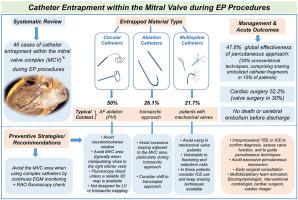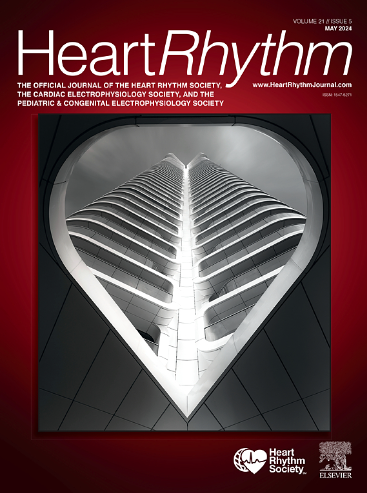The mitral valve complex: A complex trap to be avoided by cardiac electrophysiologists—A systematic review
IF 5.7
2区 医学
Q1 CARDIAC & CARDIOVASCULAR SYSTEMS
引用次数: 0
Abstract
Catheter entrapment within the mitral valve complex (MVC) is a rare but serious complication during left heart catheterization. A systematic review—the first on this topic—was conducted using PubMed and Embase databases, following the Preferred Reporting Items for Systematic Reviews and Meta-Analyses guidelines, to identify cases of catheter entrapment within the MVC during electrophysiological procedures. Forty-six patients predominantly undergoing catheter ablation of atrial tachyarrhythmias (71.7%) were included. Circular mapping catheters were the most frequently entrapped materials (50%), followed by ablation and multispline catheters. Ablation catheters were mostly entrapped when advanced retrogradely, while multispline catheter entrapment was exclusively observed in patients with mechanical valves. Percutaneous management was successful in 47.8% of patients, one-third of whom required retrieval of embolized catheter segments. Surgery was necessary in 52.2% of patients, including valve surgery in 30.4%. Awareness of this potential complication and application of preventive strategies are essential when mapping or ablating adjacent to the MVC.

二尖瓣复合体:心脏电生理学家应避免的复杂陷阱-系统综述。
导管夹持在二尖瓣复合(MVC)是一种罕见但严重的并发症在左心导管置入。根据PRISMA指南,通过PubMed和Embase数据库进行了这一主题的首次系统综述,以确定电生理过程中导管夹在MVC内的病例。46例患者主要接受导管消融治疗房性心动过速(71.7%)。圆形测图导管是最常见的包裹材料(50%),其次是消融导管和多样条导管。消融导管主要发生在进展性逆行时,而多样条导管仅发生在机械瓣膜患者中。47.8%的患者经皮处理成功,其中三分之一的患者需要取出栓塞的导管段。52.2%的患者需要手术,其中瓣膜手术占30.4%。在映射或消融MVC附近时,必须意识到这种潜在的并发症并应用预防策略。
本文章由计算机程序翻译,如有差异,请以英文原文为准。
求助全文
约1分钟内获得全文
求助全文
来源期刊

Heart rhythm
医学-心血管系统
CiteScore
10.50
自引率
5.50%
发文量
1465
审稿时长
24 days
期刊介绍:
HeartRhythm, the official Journal of the Heart Rhythm Society and the Cardiac Electrophysiology Society, is a unique journal for fundamental discovery and clinical applicability.
HeartRhythm integrates the entire cardiac electrophysiology (EP) community from basic and clinical academic researchers, private practitioners, engineers, allied professionals, industry, and trainees, all of whom are vital and interdependent members of our EP community.
The Heart Rhythm Society is the international leader in science, education, and advocacy for cardiac arrhythmia professionals and patients, and the primary information resource on heart rhythm disorders. Its mission is to improve the care of patients by promoting research, education, and optimal health care policies and standards.
 求助内容:
求助内容: 应助结果提醒方式:
应助结果提醒方式:


